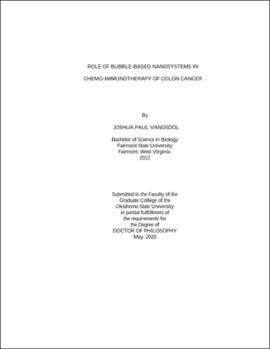| dc.contributor.advisor | Ranjan, Ashish | |
| dc.contributor.author | VanOsdol, Joshua Paul | |
| dc.date.accessioned | 2020-08-24T16:39:33Z | |
| dc.date.available | 2020-08-24T16:39:33Z | |
| dc.date.issued | 2020-05 | |
| dc.identifier.uri | https://hdl.handle.net/11244/325404 | |
| dc.description.abstract | Colorectal cancer is one of the most commonly diagnosed forms of cancer with over 4% of both men and women developing it sometime during their life. Currently, surgical excision of large tumor masses followed by chemotherapy is the preferred method of treatment. However, the large inoperable masses can be difficulty to resect with wide margins, and adjunctive chemotherapeutics do not penetrate uniformly in advanced stage tumors. Additionally, a drug's cytostatic or cytotoxic effect may not be sufficient to eliminate both the targeted tumor and developing metastases located far from the primary treated regions. To address these issues, we hypothesized that the use of High Intensity Focused Ultrasound (HIFU) in combination with a Doxorubicin (Dox) loaded Echogenic Low Temperature Sensitive Liposome (E-LTSL) would deliver sufficient drug to solid tumor masses and promote immunomodulatory effects against distant metastasis in a murine colon cancer model. To test this hypothesis we 1) developed an E-LTSL that allowed precisely controlled penetration of Dox into colon tumors under image guidance, 2) characterized the acoustic and therapeutic effects of E-LTSL nanobubbles with HIFU in an immunocompromised mice, and 3) determined the efficacy of HIFU+E-LTSL in an immunocompetent bilateral mouse colon model. The data generated from these aims indicated that HIFU+E-LTSL enhanced local drug delivery and penetration compared to traditional chemotherapeutic approaches. Interestingly, while the Dox permeation into tumor from vasculature was enhanced with HIFU+ELTSL compared to other treatments, it didn't translate into significantly improved efficacy in an immunocompromised mouse model with multiple treatments. However, in an immunocompetent mouse model, both local treatment and systemic effects were comparatively more effective with the combined treatment at reduced treatment frequencies. In conclusion, HIFU+E-LTSL increased the requisite Dox delivery to colorectal cancer and also augmented systemic anti-tumor immune response rates. | |
| dc.format | application/pdf | |
| dc.language | en_US | |
| dc.rights | Copyright is held by the author who has granted the Oklahoma State University Library the non-exclusive right to share this material in its institutional repository. Contact Digital Library Services at lib-dls@okstate.edu or 405-744-9161 for the permission policy on the use, reproduction or distribution of this material. | |
| dc.title | Role of bubble-based nanosystems in chemo-immunotherapy of colon cancer | |
| dc.contributor.committeeMember | Hinsdale, Myron | |
| dc.contributor.committeeMember | Pope, Carey | |
| dc.contributor.committeeMember | Malayer, Jerry | |
| dc.contributor.committeeMember | Piao, Daqing | |
| osu.filename | VanOsdol_okstate_0664D_16695.pdf | |
| osu.accesstype | Open Access | |
| dc.type.genre | Dissertation | |
| dc.type.material | Text | |
| dc.subject.keywords | colorectal cancer | |
| dc.subject.keywords | doxorubicin | |
| dc.subject.keywords | focused ultrasound | |
| dc.subject.keywords | nanomedicine | |
| thesis.degree.discipline | Comparative Biomedical Sciences | |
| thesis.degree.grantor | Oklahoma State University | |
